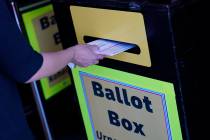Carmakers go too far with alcohol sensing systems
The improvements in vehicle safety over the past several decades are astounding, a huge factor in why traffic deaths have fallen by roughly 40 percent since the 1970s. But safer vehicles are only one part of the quest to eliminate traffic fatalities — even the safest vehicle becomes a deadly weapon when the driver operating it is distracted or driving drunk.
April has been designated both Distracted Driving Awareness Month and Alcohol Awareness Month. Both alcohol abuse and distracted driving pose huge threats on our nation’s roadways. Unfortunately, even as public safety campaigns, increased enforcement and harsher penalties for DUIs have led to dramatic decreases in drunken driving rates, distracted driving crashes are on the rise.
We’ve developed a serious love affair with our phones — a bond so strong that between 2005 and 2012, the percentage of people observed “visibly manipulating” their phones while behind the wheel increased by a whopping 650 percent.
And it’s not just our phones distracting us behind the wheel. New cars today are loaded with a host of distracting features. You can now update your Facebook status, hear your Twitter feed, get directions from your GPS and select your favorite Internet radio playlist, all without touching your phone. High-end cars can even come with in-car wifi!
Even if you are using all these gadgets hands-free, you’re still highly distracted. A University of Utah study found that drivers talking on a hands-free cellphone were just as impaired as a driver with a 0.08 blood alcohol concentration limit.
Though a number of states have passed laws banning using a handheld phone while driving and even more have passed texting and driving bans, no state has outlawed driving while talking on a Bluetooth device.
Americans have heard the distracted driving messaging, but it’s not sinking in. Teens are among the worst offenders — a recent AAA survey found that distraction was a factor in 58 percent of all teenage car crashes.
On the other hand, most Americans wouldn’t dare operate their vehicles if they’re drunk — a fact emphasized by the National Highway Traffic Safety Administration’s latest National Roadside Survey. NHTSA found that “just over 1 percent were found with 0.08 percent or higher breath alcohol content — the legal limit in every state. This is down by about 30 percent from the previous survey in 2007 and down 80 percent from the first survey in 1973.”
There’s no doubt drunken driving still poses a threat to traffic safety. However, the solution proposed by automakers and traffic safety activists isn’t an increased crackdown on the hardcore and high-BAC offenders who cause 70 percent of all drunken driving fatalities. It’s the development of in-car, passive alcohol sensing technology for installation in all cars as original equipment.
While automakers are thinking up new distracting gadgets to convince you to upgrade your car, they’re bankrolling the Driver Alcohol Detection System for Safety program. The goal of this government program is to install alcohol sensing technology in your car, regardless of whether you drink. The car would automatically read your BAC level through low-light lasers in the steering wheel or ignition button. If you’re above the pre-set limit, the car won’t start.
Due to legal and liability concerns, it’s unlikely these devices will be set at the 0.08 legal limit (as the head of the government program to create the devices has already admitted). Instead, they could be set as low as 0.03 or 0.04, effectively eliminating the ability to have even one drink and start one’s car.
As Congress drafts a new Highway Bill to continue funding national transportation programs, DADSS advocates are pushing for millions more in taxpayer funding to develop these alcohol detection devices. But policymakers shouldn’t be distracted by this misguided quest to effectively eliminate social drinking.
Instead, it’s time to tell automakers to stop loading up cars with unnecessary and dangerous distractions, and that Americans don’t want alcohol sensing technology in their cars that treat them as guilty until proved innocent every time they turn the ignition key.
If we want to make everyone safer out on the roadways, let’s dump the distractions and focus on the hardcore drunken drivers who cause the vast majority of alcohol-related fatalities.
Sarah Longwell is managing director of the American Beverage Institute, a restaurant trade association based in Washington, D.C. For more information, go to abionline.org.























